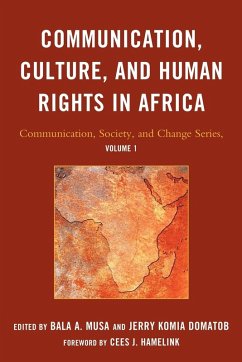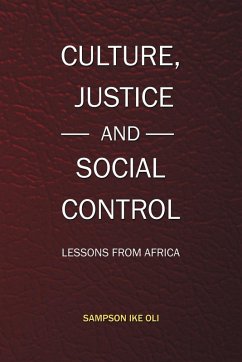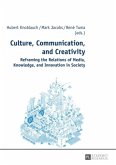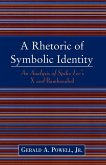Communication, Culture, and Human Rights in Africa
Herausgeber: Musa, Bala A.; Domatob, Jerry Komia
Communication, Culture, and Human Rights in Africa
Herausgeber: Musa, Bala A.; Domatob, Jerry Komia
- Broschiertes Buch
- Merkliste
- Auf die Merkliste
- Bewerten Bewerten
- Teilen
- Produkt teilen
- Produkterinnerung
- Produkterinnerung
Communication, Culture, and Human Rights in Africa provides a comprehensive and interdisciplinary analysis of the interface between human rights and civil society, the media, gender, education, religion, health communication, and political processes, weaving theory, history, policy, and case analyses into a holistic intellectual and cultural critique while offering practical solutions.
Andere Kunden interessierten sich auch für
![Culture, Justice and Social Control Culture, Justice and Social Control]() Sampson Ike OliCulture, Justice and Social Control17,99 €
Sampson Ike OliCulture, Justice and Social Control17,99 €![Culture, Communication, and Creativity Culture, Communication, and Creativity]() Culture, Communication, and Creativity87,15 €
Culture, Communication, and Creativity87,15 €![Unsung Heroes of the Civil Rights Movement and Thereafter Unsung Heroes of the Civil Rights Movement and Thereafter]() Unsung Heroes of the Civil Rights Movement and Thereafter72,99 €
Unsung Heroes of the Civil Rights Movement and Thereafter72,99 €![Fighting for Africa Fighting for Africa]() Fighting for Africa41,99 €
Fighting for Africa41,99 €![Continuing Perspectives on the Black Diaspora Continuing Perspectives on the Black Diaspora]() Aubrey W. BonnettContinuing Perspectives on the Black Diaspora62,99 €
Aubrey W. BonnettContinuing Perspectives on the Black Diaspora62,99 €![Rhetoric of Symbolic Identity Rhetoric of Symbolic Identity]() Gerald A. PowellRhetoric of Symbolic Identity50,99 €
Gerald A. PowellRhetoric of Symbolic Identity50,99 €![Soul-less Souls of Black Folk Soul-less Souls of Black Folk]() Paul C. MocombeSoul-less Souls of Black Folk44,99 €
Paul C. MocombeSoul-less Souls of Black Folk44,99 €-
-
-
Communication, Culture, and Human Rights in Africa provides a comprehensive and interdisciplinary analysis of the interface between human rights and civil society, the media, gender, education, religion, health communication, and political processes, weaving theory, history, policy, and case analyses into a holistic intellectual and cultural critique while offering practical solutions.
Produktdetails
- Produktdetails
- Verlag: University Press of America
- Seitenzahl: 294
- Erscheinungstermin: 16. Dezember 2010
- Englisch
- Abmessung: 229mm x 152mm x 17mm
- Gewicht: 481g
- ISBN-13: 9780761853077
- ISBN-10: 0761853073
- Artikelnr.: 31201915
- Herstellerkennzeichnung
- Libri GmbH
- Europaallee 1
- 36244 Bad Hersfeld
- gpsr@libri.de
- Verlag: University Press of America
- Seitenzahl: 294
- Erscheinungstermin: 16. Dezember 2010
- Englisch
- Abmessung: 229mm x 152mm x 17mm
- Gewicht: 481g
- ISBN-13: 9780761853077
- ISBN-10: 0761853073
- Artikelnr.: 31201915
- Herstellerkennzeichnung
- Libri GmbH
- Europaallee 1
- 36244 Bad Hersfeld
- gpsr@libri.de
Bala A. Musa, Ph.D., is associate professor of communication studies, Azusa Pacific University. He is author of Framing Genocide: Media, Diplomacy and Conflict and co-editor of Communication in an Era of Global Conflicts and Emerging Issues in Contemporary Journalism. Jerry Komia Domatob, Ph.D., is associate professor of mass communication, Alcorn State University. He is author of Contemporary Issues in Sub-Saharan African Political and Economic Development and African Higher Education Policy.
Chapter 1 Acknowledgements
Chapter 2 Foreword
Chapter 3 Preface
Part 4 PART I: THEORETICAL FOUNDATIONS
Chapter 5 1. Dialogic Communication Theory, African Worldview, and Human
Rights
Chapter 6 2. Political Communication Theory and Human Rights: A Look at
Nigeria's 2007 Elections
Part 7 PART II: MASS MEDIA
Chapter 8 3. The Media, Culture, and Human Rights in Sub-Saharan Africa
Chapter 9 4. Reconciling a Nation: Ghanian Journalists and the Reporting of
Human Rights
Chapter 10 5. Media Ethics and Human Rights Education in Post-Conflict
Africa
Chapter 11 6. Media and Freedom of Expression in Africa: A Comparative
Analysis of Sierra Leone and Zambia
Part 12 PART III: POWER STRUCTURES
Chapter 13 7. Restoring a Nation's Human Rights Image: A Look at Nigeria's
Political Transition Years
Chapter 14 8. Political Repression and Human Rights Abuses in Nigeria,
1999-2007
Part 15 PART IV: ALTERNATIVE MEDIA AND POPULAR CULTURE
Chapter 16 9. Media Activism, Youth Culture and Human Rights Campaigns for
the MTV Generation
Chapter 17 10. "Ushahidi" and the Kenyan Blogosphere: Alternative Online
Media in the 2007 Post-election Crisis in Kenya
Part 18 PART V: GENDER & HUMAN RIGHTS
Chapter 19 11. Gender and Cultural Violence in Africa: The Ordeal of the
Kuteb Widoq
Chapter 20 12. Gender, Human Rights, and Leadership Transition in
Pre-Islamic Hausaland
21 13. Culture, Communication, and the Right to Education of the Girl-Child
in Africa
22 PART VI: HEALTH AND COMMUNICATION
Chapter 23 14. Culture, Health Communication and Human Rights in Africa
Chapter 24 15. Health Communication and HIV/AIDS Patients' Rights
Chapter 25 16. Communicating Patients' Rights in Kenyan Hospitals: An
Analysis of Nurse-Client Interaction
26 Index
27 Contributors
Chapter 2 Foreword
Chapter 3 Preface
Part 4 PART I: THEORETICAL FOUNDATIONS
Chapter 5 1. Dialogic Communication Theory, African Worldview, and Human
Rights
Chapter 6 2. Political Communication Theory and Human Rights: A Look at
Nigeria's 2007 Elections
Part 7 PART II: MASS MEDIA
Chapter 8 3. The Media, Culture, and Human Rights in Sub-Saharan Africa
Chapter 9 4. Reconciling a Nation: Ghanian Journalists and the Reporting of
Human Rights
Chapter 10 5. Media Ethics and Human Rights Education in Post-Conflict
Africa
Chapter 11 6. Media and Freedom of Expression in Africa: A Comparative
Analysis of Sierra Leone and Zambia
Part 12 PART III: POWER STRUCTURES
Chapter 13 7. Restoring a Nation's Human Rights Image: A Look at Nigeria's
Political Transition Years
Chapter 14 8. Political Repression and Human Rights Abuses in Nigeria,
1999-2007
Part 15 PART IV: ALTERNATIVE MEDIA AND POPULAR CULTURE
Chapter 16 9. Media Activism, Youth Culture and Human Rights Campaigns for
the MTV Generation
Chapter 17 10. "Ushahidi" and the Kenyan Blogosphere: Alternative Online
Media in the 2007 Post-election Crisis in Kenya
Part 18 PART V: GENDER & HUMAN RIGHTS
Chapter 19 11. Gender and Cultural Violence in Africa: The Ordeal of the
Kuteb Widoq
Chapter 20 12. Gender, Human Rights, and Leadership Transition in
Pre-Islamic Hausaland
21 13. Culture, Communication, and the Right to Education of the Girl-Child
in Africa
22 PART VI: HEALTH AND COMMUNICATION
Chapter 23 14. Culture, Health Communication and Human Rights in Africa
Chapter 24 15. Health Communication and HIV/AIDS Patients' Rights
Chapter 25 16. Communicating Patients' Rights in Kenyan Hospitals: An
Analysis of Nurse-Client Interaction
26 Index
27 Contributors
Chapter 1 Acknowledgements
Chapter 2 Foreword
Chapter 3 Preface
Part 4 PART I: THEORETICAL FOUNDATIONS
Chapter 5 1. Dialogic Communication Theory, African Worldview, and Human
Rights
Chapter 6 2. Political Communication Theory and Human Rights: A Look at
Nigeria's 2007 Elections
Part 7 PART II: MASS MEDIA
Chapter 8 3. The Media, Culture, and Human Rights in Sub-Saharan Africa
Chapter 9 4. Reconciling a Nation: Ghanian Journalists and the Reporting of
Human Rights
Chapter 10 5. Media Ethics and Human Rights Education in Post-Conflict
Africa
Chapter 11 6. Media and Freedom of Expression in Africa: A Comparative
Analysis of Sierra Leone and Zambia
Part 12 PART III: POWER STRUCTURES
Chapter 13 7. Restoring a Nation's Human Rights Image: A Look at Nigeria's
Political Transition Years
Chapter 14 8. Political Repression and Human Rights Abuses in Nigeria,
1999-2007
Part 15 PART IV: ALTERNATIVE MEDIA AND POPULAR CULTURE
Chapter 16 9. Media Activism, Youth Culture and Human Rights Campaigns for
the MTV Generation
Chapter 17 10. "Ushahidi" and the Kenyan Blogosphere: Alternative Online
Media in the 2007 Post-election Crisis in Kenya
Part 18 PART V: GENDER & HUMAN RIGHTS
Chapter 19 11. Gender and Cultural Violence in Africa: The Ordeal of the
Kuteb Widoq
Chapter 20 12. Gender, Human Rights, and Leadership Transition in
Pre-Islamic Hausaland
21 13. Culture, Communication, and the Right to Education of the Girl-Child
in Africa
22 PART VI: HEALTH AND COMMUNICATION
Chapter 23 14. Culture, Health Communication and Human Rights in Africa
Chapter 24 15. Health Communication and HIV/AIDS Patients' Rights
Chapter 25 16. Communicating Patients' Rights in Kenyan Hospitals: An
Analysis of Nurse-Client Interaction
26 Index
27 Contributors
Chapter 2 Foreword
Chapter 3 Preface
Part 4 PART I: THEORETICAL FOUNDATIONS
Chapter 5 1. Dialogic Communication Theory, African Worldview, and Human
Rights
Chapter 6 2. Political Communication Theory and Human Rights: A Look at
Nigeria's 2007 Elections
Part 7 PART II: MASS MEDIA
Chapter 8 3. The Media, Culture, and Human Rights in Sub-Saharan Africa
Chapter 9 4. Reconciling a Nation: Ghanian Journalists and the Reporting of
Human Rights
Chapter 10 5. Media Ethics and Human Rights Education in Post-Conflict
Africa
Chapter 11 6. Media and Freedom of Expression in Africa: A Comparative
Analysis of Sierra Leone and Zambia
Part 12 PART III: POWER STRUCTURES
Chapter 13 7. Restoring a Nation's Human Rights Image: A Look at Nigeria's
Political Transition Years
Chapter 14 8. Political Repression and Human Rights Abuses in Nigeria,
1999-2007
Part 15 PART IV: ALTERNATIVE MEDIA AND POPULAR CULTURE
Chapter 16 9. Media Activism, Youth Culture and Human Rights Campaigns for
the MTV Generation
Chapter 17 10. "Ushahidi" and the Kenyan Blogosphere: Alternative Online
Media in the 2007 Post-election Crisis in Kenya
Part 18 PART V: GENDER & HUMAN RIGHTS
Chapter 19 11. Gender and Cultural Violence in Africa: The Ordeal of the
Kuteb Widoq
Chapter 20 12. Gender, Human Rights, and Leadership Transition in
Pre-Islamic Hausaland
21 13. Culture, Communication, and the Right to Education of the Girl-Child
in Africa
22 PART VI: HEALTH AND COMMUNICATION
Chapter 23 14. Culture, Health Communication and Human Rights in Africa
Chapter 24 15. Health Communication and HIV/AIDS Patients' Rights
Chapter 25 16. Communicating Patients' Rights in Kenyan Hospitals: An
Analysis of Nurse-Client Interaction
26 Index
27 Contributors








